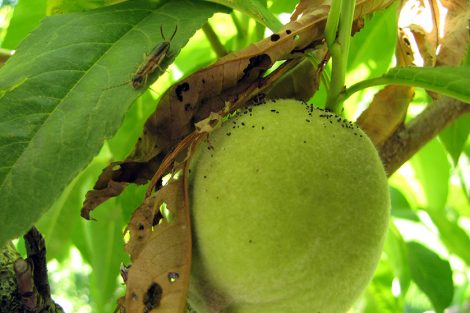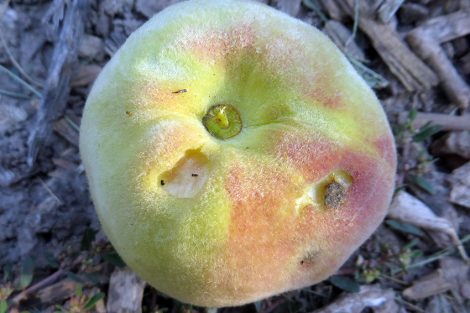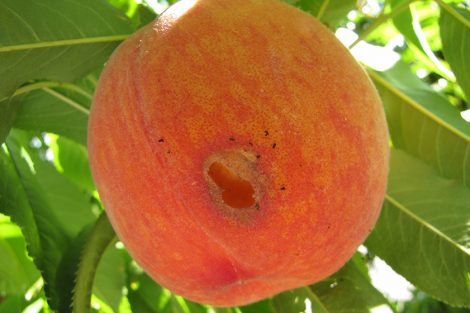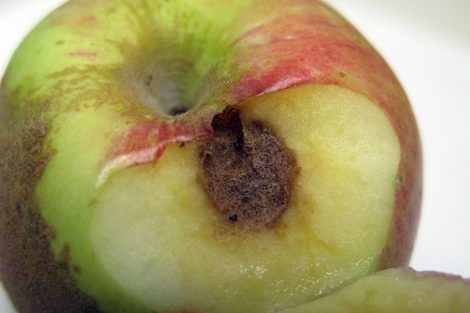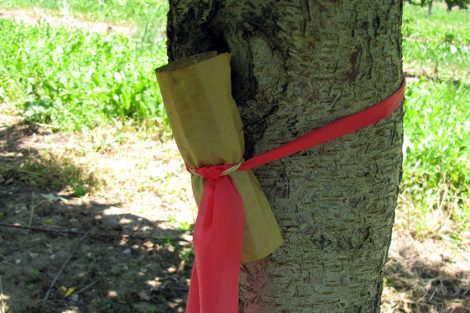In this Issue
- Apple and Pear: end fruit protection for codling moth Sept 15; white apple leafhopper nymphs are still active
- Peach/nectarine and Cherry: watch rain forecast to prevent cornyeum blight; cherry fruit fly post-harvest; continue protecting trees from greater peachtree borer through mid-October
- All trees: earwigs; crown rot
- Raspberry: raspberry crown borer treatment in fall
APPLE, PEAR
Codling Moth
provide continuous protection of fruit until Sept. 15
In the summer heat, codling moth larvae are present almost continuously. Therefore, keep fruit protected regularly with an insecticide. After September 15, (or after harvest, whichever is earlier), stop spraying. Mid-September is the time when the eggs stop hatching due to shorter day-lengths.
White Apple Leafhopper
will be a nuisance at picking if not treated now
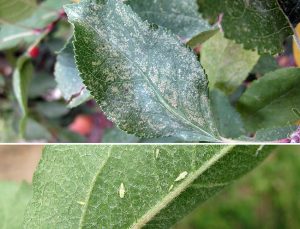
Where present, second leafhopper nymphs are present on the undersides of apple foliage. If your orchard had a high population of the first generation, now would be a good time to treat to prevent a nuisance of adults during harvest. Nymphs are easier to treat than the adults because they are less mobile. Adult activity will become very noticeable by mid September.
Note that feeding on the foliage will not affect apple yield or tree health.
Treatment
- Backyard growers can use 1% oil, insecticidal soap, or Safer BioNeem
- Options for commercial growers: click here.
PEACH/NECTARINE AND CHERRY
Peach Twig Borer
some sites may need one final application
View the updated spray timing pdf table here. In northern Utah, egg hatch for the third generation will be occurring soon. In these locations, we recommend applying one last cover spray to protect fruit through September 15. In other areas, the predicted timing for third generation is after Sept 15, so no treatment is necessary in those locations.
In southern Utah, we have noted the egg hatch timing for fourth generation on the pdf table.
Treatment
- Please see the advisory from June 6, 2022 for recommended insecticide options.
Coryneum Blight
rains can bring on infections of fruit
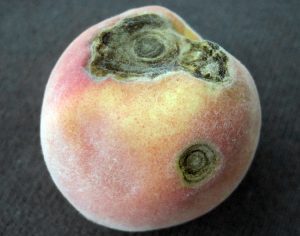
As peach fruit ripens and becomes soft, there is a risk of late-season infections occurring, especially with heavy rains. These infections look different from early-season infections and sometimes, the damage will not show up until after harvest.
Protection against late season infections on ripening fruit is particularly important where there is a history of this disease. During the three to four weeks before harvest, be diligent about monitoring your fruit, and apply a fungicide before a forecasted rainfall (ideally). Conditions that are optimal for infection include at least 4 hours of rainfall and cooler temperatures of 70 F to 80°F.
New infections are visible on maturing fruit in a matter of 2 to 5 days, and most often, render the fruit inedible.
Treatment
- Residential growers can use Spectracide Immunox, Fertilome F-stop, or Captan.
- Commercial growers options: click here.
Greater Peachtree Borer (For Backyard Growers)
continue protection of trunk through mid-October
Continue to maintain protection of the lower trunk of peach/nectarine and apricot (where necessary) with your last treatment around September 15 (so that the trunk is protected through Oct 15). When you spray, be sure to move mulch or weeds away from the trunk (or even excess soil) because sometimes eggs are laid below grade.
This fall or next spring, determine the success of your treatment program by inspecting your trees. Remove dirt from around the base of the tree down to about 4 inches. Look for oozing gum mixed with frass. If you find any symptoms, you will know that you need to improve your control program for next year.
Treatment
- Backyard growers can use Hi Yield Permethrin, Sevin, Spectracide Triazicide, or for organic control, products containing spinosad.
Western Cherry Fruit Fly Post-Harvest
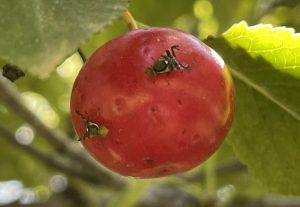
don’t forget about the fruit left on the tree
In the July 20, 2022 advisory, we noted that cherry fruit fly activity peaks AFTER harvest, and untreated fruit that remain on the tree represent a source for infestation the following season.
We were in the orchards this week and found plenty of fruit flies settling on unharvested fruit and laying eggs.
In commercial orchards, apply an insecticide such as imidacloprid (Admire Pro, or generics) after harvest to reduce fly populations for the following year, especially in orchards with high post-harvest catches. Dimethoate plus 1% oil is another option.
For backyard trees, please remove and destroy all fallen fruit, and if possible, pick your cherry trees clean to remove egg-laying sites for late-emerging fruit flies. Please play your role in keeping your trees clean of this pest that can devastate a commercial growers’ crop.
ALL FRUITS AND RASPBERRY
Earwigs
Signs of earwig feeding (excrement) are commonly found on and in ripening peaches and apples. Earwigs do not like dry conditions, so they are concentrated in areas that are irrigated especially if there are moist, cool areas to hide during the day. They feed mostly at night, sometimes creating deep pits into the fruit flesh or finding their way inside the fruit through the stem or other crack. They always leave clues of their presence behind: dots of black excrement.
Treatment
To manage earwigs, use a variety of options from the list shown below:
Regular trapping: For small farm or backyard situations, regular trapping is a highly effective tool. Options are: cat food or tuna cans, with 1/2-inch of a smelly oil (fish or bacon) in the bottom; rolled-up dampened newspaper; rolled up corrugated cardboard; bamboo sticks; short pieces of hose. Place traps on the soil or wrapped around the tree trunk and empty traps into soapy water, or change them out, daily. Continue until you are no longer catching earwigs.
Remove refuge sites: Earwigs hide in dark, moist environments. Where possible, keep mulch away from trees and remove weedy growth or groundcovers from the base of trees. Remove tree suckers or any limbs touching the ground. Remove loose bark on fruit trees where earwigs can hide.
Sanitation: Pick fruit as soon as it starts to ripen and clean up dropped fruit.
Insecticides: Spinosad (many residential and commercial brands) kills earwigs after they feed on the residual material. It can be used either as a spray or bait sprinkled at the base of trees (Sluggo Plus). (In this method, the bait must be used before the earwigs enter the tree. Otherwise, sprinkle bait in tree crotches.) Carbaryl (commercial growers) can also be used, applied to the tree trunk and scaffold limbs, but again, it must be applied as soon as earwigs are starting to enter the tree.
Phytophthora Crown Rot
what to consider when a tree dies suddenly
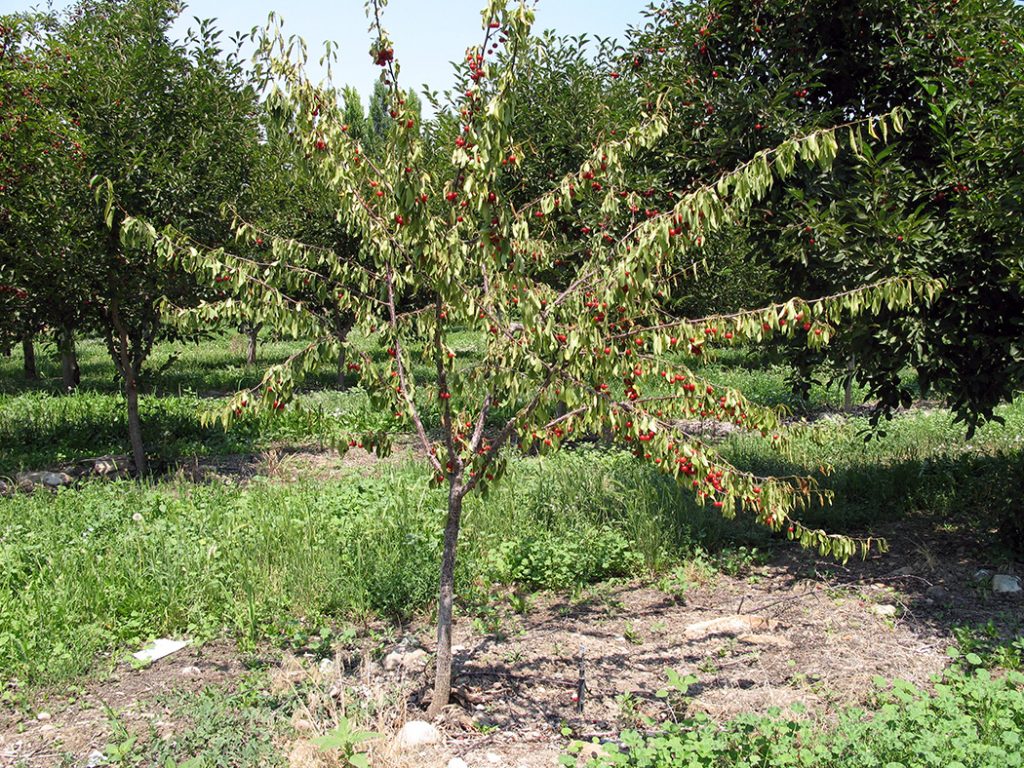
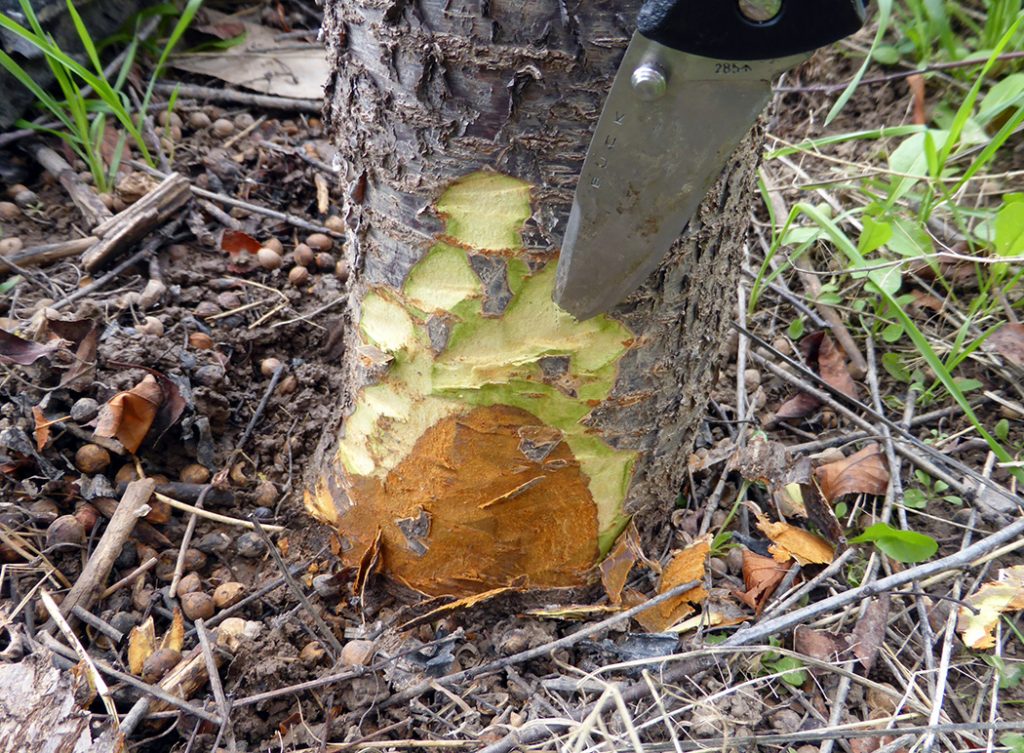
Trees older than a few years that die suddenly during periods of high heat may have been living with an infection caused by Phytophthora that occurred earlier in the season.
Phytophthora crown rot is a disease that kills the cambium at the base of the tree (cambium), preventing the flow of water and nutrients. An infected tree exposed to the stress of heat, drought, and bearing fruit can result in a quick death.
This disease can be diagnosed by scraping the outer bark away from the base of the tree (at soil level) to look for the cinnamon colored, diseased cambium.
Phytophthora species are present in many soils, but infection only occurs with the combination of saturated soil conditions (for at least 8 hours) and a susceptible host. Trees planted too deeply in clay soils are at greatest risk. The pathogen can also spread from tree to tree via root contact.
Treatment
To prevent infection
- Avoid planting trees in low spots or in poorly drained soils.
- Plant new trees slightly high so that they do not settle lower than the normal soil grade.
- Prevent water from puddling around the root collar by reducing irrigation or improving drainage.
Trees that have become infected cannot be cured. However, neighboring trees of the same species may be at risk. These nearby trees can be protected with a foliar treatment of phosphorus acid (Agri-Fos, Fosphite, GardenPhos, others). This treatment helps the tree(s) develop tolerance to infection.
RASPBERRY
Raspberry Crown Borer
treat in early fall
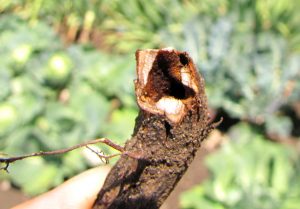
If you are noticing entire canes or plants wilting in your raspberry patch, it is possibly damage from the raspberry crown borer. At this time of year, the larvae of this pest are actively feeding and tunneling in the roots and crowns, which cuts off the flow of water and nutrients.
To determine crown borer, yank on the symptomatic cane. If you can easily pull it out of the ground, it could be crown borer. Look at the broken end, and you may see some tunneling damage in the lower part of the cane.
The raspberry crown borer belongs to a group of moths called clearwing moths. Their larvae live and bore into the crown and roots of blackberries, raspberries, loganberries, and wild brambles for two years. Young larvae feed on the smaller roots, and as they get larger, they move to the crown. Damage is most evident during the second year of larval activity. Mature larvae pupate to a moth in mid to late August.
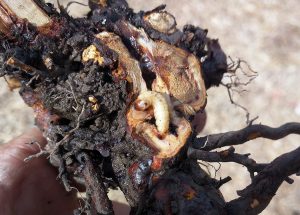
The problem with this pest is that low levels of infestation can suddenly develop into a severe problem, so it is important to keep an eye on the health of your plants during the entire season.
Early fall is the best time for treatment because at that time, larvae exit the upper crown of the plant and are exposed in the soil for a short period of time. Eventually, they travel down in the soil to the roots for the winter. In infested sites, at least two years of diligent treatment is necessary.
Treatment
- In early fall (late September to early October), drench the soil around the crowns of symptomatic and neighboring plants with a product that contains bifenthrin.

